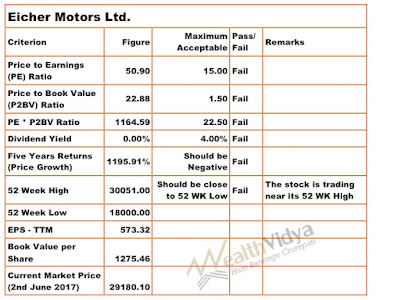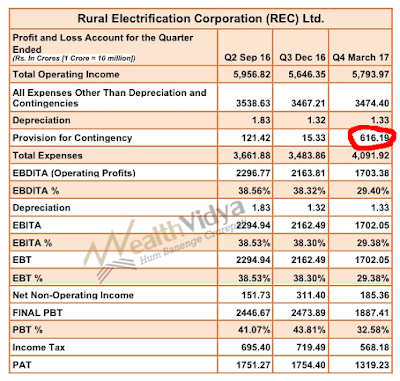In
this article I shall describe the stocks I have invested in yesterday for
January 2017 and how I ended up selecting them. While the theme for investments
in the last few months had been buying assets at a discount, this month the
theme is “Balance”. The balance is between ‘Price to Book Value’, ‘Price
to Earnings’ and the product of the first two. We are already familiar with the
thresholds for these three parameters but still let us list them:
- Price
to Book Value (P2BV): Not more than 1.5
- Price
to Earnings (PE): Not more than 15
- Product
or combination of the above two ratios (P2BV*PE): Not more than 22.5
The
stocks evaluated on the above criteria were all the 15 serious, individual shares
figuring in our ‘Portfolio 2K15’, other than the exchange traded funds.
As
there are three parameters or criteria, the investible sum had been determined as
a multiple of three. It could have been Rs.900, 1800, 2100, 2700 and so on. I
had selected Rs.21000. This figure suits many middle class wage-earning
Indians. I allocated this sum of Rs.21000 equally among the three criteria at
Rs.7000 each.
Kindly note that no efforts were either invested nor
required for calculating the P2BV and PE Ratios of the stocks; they are readily
available on many financial websites. I have taken the figures from “Economic
Times”.
The
three criteria are individually and independently applied to the said 15 stocks
as follows:
Price to Book Value Ratio:
Criterion: P2BV; Threshold:
≤ 1.5
|
Max permitted
|
Current P2BV Ratios
|
Discount in P2BV
|
Weightage (% of
individual scrip discount to total of positive discounts)
|
Allocation of Individual
Investible Amount Rs. 7000 as per the weightage
|
1
|
NHPC
|
0.95
|
0.55
|
7.63%
|
534
|
2
|
PFC
|
0.45
|
1.05
|
14.56%
|
1019
|
3
|
REC
|
0.43
|
1.07
|
14.84%
|
1039
|
4
|
NMDC
|
1.77
|
-0.27
|
|
|
5
|
CAIRN
|
0.93
|
0.57
|
7.91%
|
553
|
6
|
SJVN
|
1.12
|
0.38
|
5.27%
|
369
|
7
|
Neyveli
Lignite
|
0.89
|
0.61
|
8.46%
|
592
|
8
|
ONGC
|
0.93
|
0.57
|
7.91%
|
553
|
9
|
NALCO
|
1.32
|
0.18
|
2.50%
|
175
|
10
|
MOIL
|
1.84
|
-0.34
|
|
|
11
|
HZL
|
2.84
|
-1.34
|
|
|
12
|
OIL
|
1.22
|
0.28
|
3.88%
|
272
|
13
|
GE SHIP
|
0.68
|
0.82
|
11.37%
|
796
|
14
|
VEDANTA
|
1.44
|
0.06
|
0.83%
|
58
|
15
|
SCI
|
0.43
|
1.07
|
14.84%
|
1039
|
|
Sum of Positive Discounts
|
|
7.21
|
100.00%
|
7000
|
A
close examination of the above table reveals that those stocks that are not
offering a positive discount in the P2BV (the positive number obtained
from deducting the current P2BV from 1.5) are eliminated and their negative discounts
excluded from counting the total discount of 7.21. The individual weightages
are arrived at by dividing the individual discounts with the total of positive
discounts, of 7.21. The investible sum set a part for the P2BV criterion of
Rs.7000 has been allocated to each individual scrip based on this weightage.
In
simple terms we have allocated maximum amount to the scrip offering maximum
positive discount and least sum to the share offering the least discount.
Price to Earnings Ratio:
A similar
exercise is carried out with the ‘Price to Earnings (PE) criterion and the
results are as follows:
Criterion PE; Max
permitted PE = 15
|
Scrip
|
Current PE
|
Discount in PE
|
Weightage
|
Allocation of Investible
Amount Rs. 7000
|
1
|
NHPC
|
10.46
|
4.54
|
11.47%
|
803
|
2
|
PFC
|
5.08
|
9.92
|
25.07%
|
1755
|
3
|
REC
|
2.16
|
12.84
|
32.45%
|
2271
|
4
|
NMDC
|
15.79
|
-0.79
|
0
|
0
|
5
|
CAIRN
|
96.59
|
-81.59
|
0
|
0
|
6
|
SJVN
|
9.16
|
5.84
|
14.76%
|
1033
|
7
|
Neyveli
Lignite
|
13.13
|
1.87
|
4.73%
|
331
|
8
|
ONGC
|
16.98
|
-1.98
|
-5.00%
|
0
|
9
|
NALCO
|
21.21
|
-6.21
|
0
|
0
|
10
|
MOIL
|
40.88
|
-25.88
|
0
|
0
|
11
|
HZL
|
15.39
|
-0.39
|
0
|
0
|
12
|
OIL
|
14.04
|
0.96
|
2.43%
|
170
|
13
|
GE SHIP
|
11.98
|
3.02
|
7.63%
|
534
|
14
|
VEDANTA
|
14.42
|
0.58
|
1.47%
|
103
|
15
|
SCI
|
33.82
|
-18.82
|
0
|
0
|
|
Sum of Positive discounts
|
|
39.57
|
95.00%
|
7000
|
- Again
the stock trading at the lowest PE multiple and therefore offering the maximum
discount to the maximum permitted PE multiple of 15 had got the maximum
allocation of the investible sum.
- For
example REC with the lowest PE of 2.16 and maximum discount of 12.84 (15-2.16)
got the maximum allocation of 32.45%; Vedanta with maximum PE multiple of 14.42
and the least discount of 0.58 ended up with the least allocation of 1.47%.
- Those
scrips trading above the maximum permitted PE Multiple of 15 got totally eliminated.
- And
finally some scrips got allocation under the criterion of P2BV did not get any
allocation under this PE criterion – example CAIRN.
PE*P2BV Ratio:
Value
Investing principles require that besides the above two criteria independently
applied, the combined effect or the result of the above two criteria shall not
exceed 22.5 (15*1.5 = 22.5). I applied this third condition, ascertained the
discount (22.5 – actual PE*P2BV number), made the allocation based on the
discount percentage and the results are as follows:
Criterion PE*P2BV; Max
permitted = 22.5
|
Scrip
|
Actual PE*P2BV Value
|
Discount
|
Weightage/ Discount %
|
Allocation of Investible
Amount Rs. 7000
|
1
|
NHPC
|
9.937
|
12.563
|
11.07%
|
775
|
2
|
PFC
|
2.286
|
20.214
|
17.81%
|
1246
|
3
|
REC
|
0.9288
|
21.5712
|
19.00%
|
1330
|
4
|
NMDC
|
27.9483
|
-5.4483
|
|
0
|
5
|
CAIRN
|
89.8287
|
-67.3287
|
|
0
|
6
|
SJVN
|
10.2592
|
12.2408
|
10.78%
|
755
|
7
|
Neyveli
Lignite
|
11.6857
|
10.8143
|
9.53%
|
667
|
8
|
ONGC
|
15.7914
|
6.7086
|
5.91%
|
414
|
9
|
NALCO
|
27.9972
|
-5.4972
|
|
0
|
10
|
MOIL
|
75.2192
|
-52.7192
|
|
0
|
11
|
HZL
|
43.7076
|
-21.2076
|
|
0
|
12
|
OIL
|
17.1288
|
5.3712
|
4.73%
|
331
|
13
|
GE SHIP
|
8.1464
|
14.3536
|
12.64%
|
885
|
14
|
VEDANTA
|
20.7648
|
1.7352
|
1.53%
|
107
|
15
|
SCI
|
14.5426
|
7.9574
|
7.01%
|
491
|
|
Sum of Positive Discounts
|
|
113.5293
|
100%
|
7000
|
Sum of the three allocations:
Having
completed the assessments based on the three criteria as above, we now sum-up
the three amounts allocated for each scrip. Next the number of shares that can
be bought is ascertained by dividing the allocated sum by the current market
price of the share. Once this quantity was available I just placed the order
online and bought the shares as follows:
Conclusion:
In
the end I had allocated an investible sum for investment in the month of
January 2017 and it resulted in the independent assessment based on three fair
valuation criteria on the constituents of our Portfolio2K15 resulting in a balanced allocation. Three shares highlighted
in red background and white foreground, were totally rejected and the rest 12
had all received provision depending on their merit.






